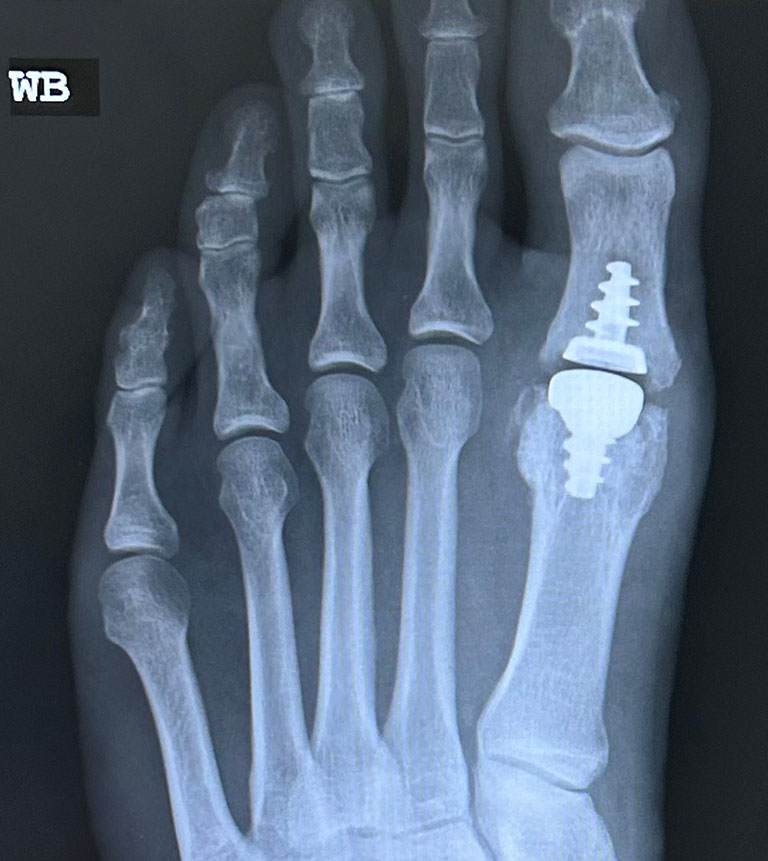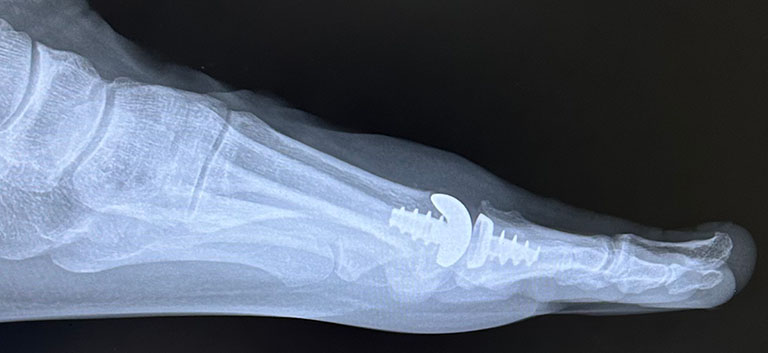MTP Joint Replacement
Arthritis of the big toe joint (first metatarsophalangeal or MTP) can cause pain and swelling. This can produce the classic bulging of the joint which often makes it uncomfortable to walk or wear certain footwear. Arthritis develops when the cartilage which acts as the cushion and lubricant in the joint wears away and the two bones that make up the big toe joint rub against one another.
The traditional treatment for this condition would be a fusion which makes the joint rigid, but pain free.
The ToeMotion® is a specifically contoured metal replacement which resurfaces the degenerate joint by replacing both the 'ball & socket' joints of the big toe.


Over the years we've become familiar with the idea of replacing all or parts of joints with prosthetic implants. Using modern materials and precision surgery techniques, the results can be quite outstanding in terms of relieving pain and restoring almost normal mobility.
The ToeMotion® joint restoration technology is an excellent option for patients who are seeking to maintain a more active lifestyle and it increases the options beyond a cheilectomy or a fusion plate.
The ToeMotion® implants are carefully designed to match the cartilage contour of individual joints so that the cap replaces only the area of damaged cartilage.
The implant replaces both sides of the joint and works to maintain the natural movement of your foot and toes.
Instead of a one-piece implant elements with a stem built in, the ‘ball’ side ToeMotion® element consists of a cap and screw that join and aids in a more precise sizing and positioning. These implants are well proven and robust with no reported loosening.
However, it is important to note that the medium to long term results of this operation are not known. It should only be undertaken if it is accepted that a further operation to fuse the joint is likely to be necessary at some point in the future.
Risks of surgery
Swelling
Initially the foot will be very swollen and needs elevating. The swelling will disperse over the following weeks & months but will still be apparent at 6-9 months.
Infection
There is always a risk of infection with surgery. You will be given 1 dose of intravenous antibiotics during surgery. The best way to reduce your chances of acquiring an infection is to keep the foot elevated for 10 days. If there is an infection, it normally resolves with a course of oral antibiotics.
Stiffness
The toe will naturally be stiff after surgery, but this rapidly recovers with simple exercises starting at 2 weeks.
Incomplete relief of symptoms
This operation has been shown to provide good pain relief, although complete relief of symptoms is not guaranteed and should not be expected.
Long term results
At present, we do not know the long term benefit or failure rate of this implant / operation. As such, it is important to understand a future operation to fuse the joint may be required.
Recovery from surgery
This procedure has the advantages of a quick recovery (walking in normal shoes by 2 weeks) and that motion in the joint is preserved.
The replacement must be protected with the specialised dressing for 2 weeks, at which stage normal shoes can be worn if possible. This type of operation and the post operative shoe allow weight bearing (walking) immediately. Often this may be too uncomfortable for the first week.
Elevation of the foot (above the pelvis) for the first 10 days is vitally important to prevent infection. Naturally, small periods of walking and standing are necessary.
The surgery is routine, but the recovery is prolonged and swelling is the last feature to recover. Often shoeware will still be tight at the 6-week stage.
Activity and time off work
In general, 2 weeks off work is required for sedentary posts. 4 weeks for standing or walking posts. 6 weeks for manual / labour posts.
Follow up
- 2 weeks for removal of sutures
- 6 weeks in Foot & Ankle clinic: weight bearing Xray
- 6 months: X-ray, Annual X-rays